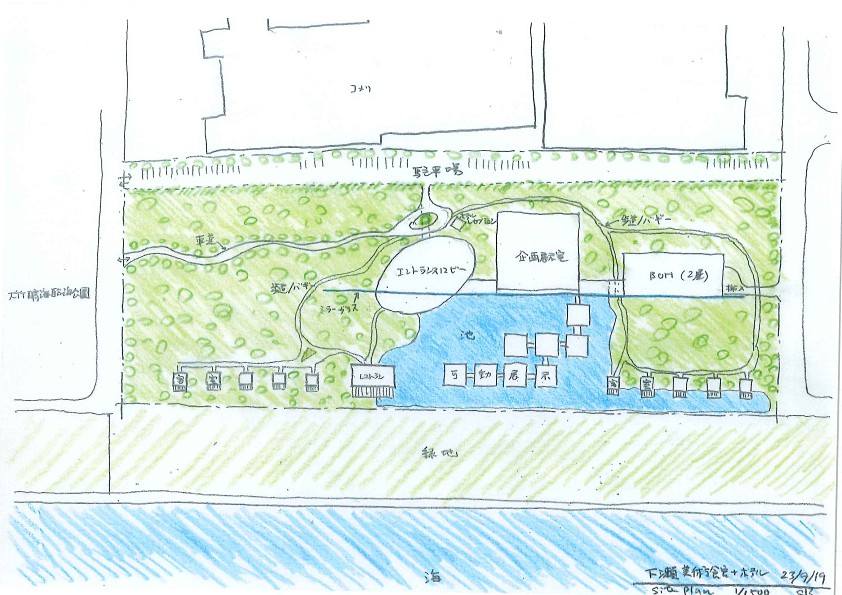SPACE July 2024 (No. 680)

시모세 마스터플랜 스케치
Geometry, Materials, Structure, Space
I finally sit at my desk, days after the deadline for finishing my manuscript. But I still don’t know what to say about Ban Shigeru’s architecture. It would be redundant to write that the 2014 laureate of the Pritzker Architecture Prize and worldwide architect is good at architecture. (I don’t think the Pritzker Architecture Prize is a universal evaluation standard of architects, and I’ll discuss the issue at length next time.) Nevertheless, I reflected on Japanese laureates of the Pritzker Architecture Prize. Tange Kenzo (1913 – 2005) won the prize at age 73 in 1987, Maki Fumihiko (1928 – 2024) at 64 in 1993, Ando Tadao (1941 –) at 53 in 1995, Sejima Kazuyo (1956 –) and Ryuue Nishizawa (1966 –) at 53 and 43 respectively in 2010, Ito Toyo (1941 –) at 71 in 2013, Ban Shigeru (1957 –) at 56 in 2014, Isozaki Arata (1931 – 2022) at 88 in 2019, and Yamamoto Riken (1945 –) at 78 in 2024.▼1 They can be categorised as follows; Tange Kenzo, Ito Toyo, Isozaki Arata, and Yamamoto Riken were awarded in their 70s and 80s as a tribute to the elders, while Maki Fumihiko, Ando Tadao, Sejima Kazuyo, and Ban Shigeru were awarded in their 50s and 60s for their messages to the world of architecture. (Nishizawa Ryu was exceptionally awarded in his early 40s, but he was the joint recipient of the award.)
What characterises the architecture of Maki Fumihiko, Ando Tadao, Sejima Kazuyo, and Ban Shigeru? If we consider the reasons why they are so highly regarded, the first two stand out for their research of modernism and its relation to Japan, Sejima Kazuyo has delved into the relationship between society, space and form, while Ban Shigeru has shown an extraordinary interest in materials and structure. He said, ‘I always aim to develop structural ideas further. I keep developing ideas adopted in competitions until they are realised, but I never repeat the same structural design again.’▼2
I didn’t realise that Ban Shigeru is an architect with a keen interest in structure, and that he learned a lot about structure from Matsui Gengo until I participated in this FRAME. Until then, I thought of him as an architect who uses ‘paper’ and who has taken an active role in designing architecture for sites of disaster such as earthquakes. When I visited Tainan Art Museum Building 2 in June 2019 to attend the opening symposium, I found that he was the architect of the building and was amazed at the fact that he uses steel. Around the same time, I saw his office building in Tokyo’s Ginza, which is not made of paper or wood.
In an interview with SPACE in March at Haesley Hamlet in Yeoju, Ban Shigeru mentioned teachers in his architectural journey. John Hejduk taught him how to organise forms with geometry and the Cooper Union’s educational policy, and Matsui Gengo provided him with the structural foundation to build with paper. Matsui Gengo taught him that ‘structure is not for constraining something, but for expanding possibilities.’▼3 From Frei Otto, he learned how to create large spaces with shell structures, which gave birth to Paper Tube Grid-Shell Structure. Frei Otto’s philosophy was ‘to create the maximum amount of space with the minimum number of materials and energy’. This philosophy is realised in the Centre Pompidou-Metz (2010), which resonates with the sentiment of ‘wastefulness’ described later.▼4 Then, Ban Shigeru learned from Hermann Blumer how to use glulam efficiently to make spaces. He understood the properties and features of wood well, and he triggered the shift of Ban Shigeru’s architecture from paper to wood.▼5
...
※You can see more information on the SPACE No. August (2024).
_
1. The laureate of the Pritzker Architecture Prize is announced in the spring of each year, so the architects’ ages may be different by a year from the ages listed above according to their birth dates.
2. ‘Haesley Hamlet’, SPACE No. 646 (Sep. 2021), p. 38.
3. Ban Shigeru, Paper Architecture in Action, trans. Park Jae-Young, Seoul: Minumsa, 2019, p. 150.
4. Ban Shigeru, ‘Why I do Love Wooden Architecture?’, Timber in Architecture, New York: Rizzoli, 2022, p. 17.
5. This is documented in detail in Ban Shigeru’s essay, ‘Why Do I Love Wooden Architecture?’, pp. 14–19.





